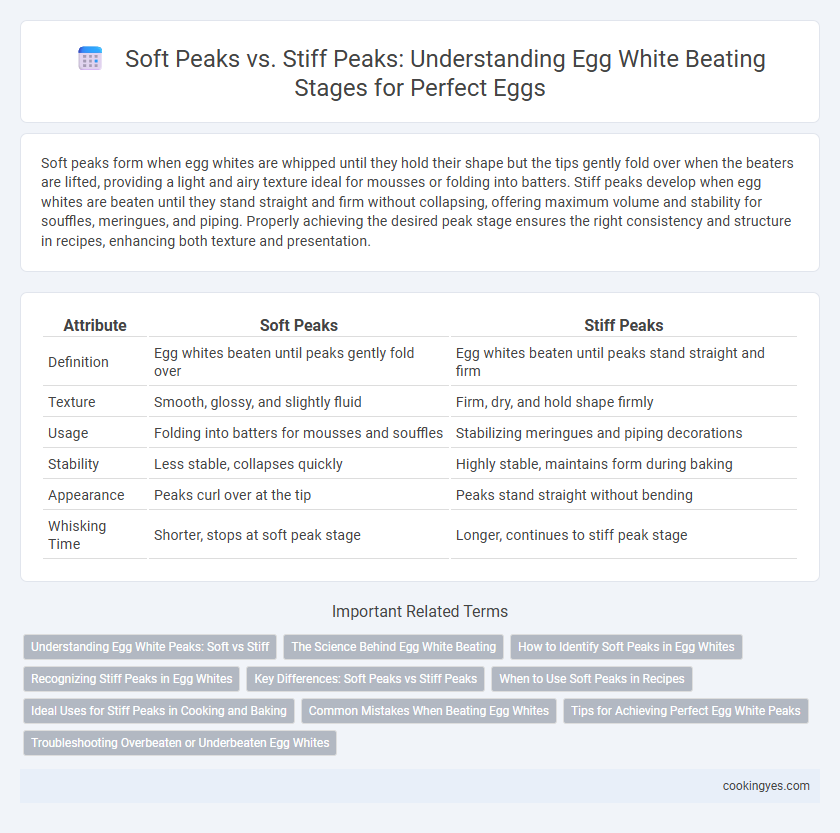Soft peaks form when egg whites are whipped until they hold their shape but the tips gently fold over when the beaters are lifted, providing a light and airy texture ideal for mousses or folding into batters. Stiff peaks develop when egg whites are beaten until they stand straight and firm without collapsing, offering maximum volume and stability for souffles, meringues, and piping. Properly achieving the desired peak stage ensures the right consistency and structure in recipes, enhancing both texture and presentation.
Table of Comparison
| Attribute | Soft Peaks | Stiff Peaks |
|---|---|---|
| Definition | Egg whites beaten until peaks gently fold over | Egg whites beaten until peaks stand straight and firm |
| Texture | Smooth, glossy, and slightly fluid | Firm, dry, and hold shape firmly |
| Usage | Folding into batters for mousses and souffles | Stabilizing meringues and piping decorations |
| Stability | Less stable, collapses quickly | Highly stable, maintains form during baking |
| Appearance | Peaks curl over at the tip | Peaks stand straight without bending |
| Whisking Time | Shorter, stops at soft peak stage | Longer, continues to stiff peak stage |
Understanding Egg White Peaks: Soft vs Stiff
Soft peaks form when egg whites are whipped until they hold a gentle, drooping shape that folds over easily, ideal for recipes requiring light aeration like mousses and souffles. Stiff peaks occur when egg whites are beaten until they stand upright and maintain a firm shape, essential for stable meringues and souffle bases. Properly identifying the difference between soft and stiff peaks ensures precise texture and volume in culinary preparations.
The Science Behind Egg White Beating
Egg white beating involves denaturing proteins such as ovalbumin, allowing them to unfold and form a stable network that traps air bubbles. Soft peaks occur when the protein matrix is partially formed, resulting in flexible, glossy peaks that bend gently, while stiff peaks form when the network is fully developed, creating firm, rigid peaks that stand straight. The degree of protein denaturation and water-protein interaction directly influences the texture and stability of the foam, crucial for recipes requiring specific peak consistencies.
How to Identify Soft Peaks in Egg Whites
Soft peaks in egg whites are identified when the mixture forms gentle, drooping peaks that slightly hold shape but collapse softly when the beaters are lifted. The texture appears glossy and smooth, with peaks that curve downwards rather than standing upright. This stage is ideal for recipes requiring light aeration without overly stiff textures.
Recognizing Stiff Peaks in Egg Whites
Recognizing stiff peaks in egg whites involves lifting the whisk and observing firm, pointed peaks that stand straight without drooping, indicating maximum aeration and volume. This stage is essential for recipes requiring strong structural support, such as meringues and souffles. The texture should be glossy and thick, ensuring the egg whites have been beaten to the correct consistency for optimal stability.
Key Differences: Soft Peaks vs Stiff Peaks
Soft peaks in egg white beating are characterized by a gentle, droopy tip that bends over when the whisk is lifted, indicating moderate aeration suitable for folding into batters. Stiff peaks stand firm with sharp tips that hold their shape without bending, reflecting maximum volume and stability essential for meringues and souffles. The key difference lies in the texture and firmness, where soft peaks provide flexibility and lighter structure, while stiff peaks ensure rigidity and durability in recipes.
When to Use Soft Peaks in Recipes
Soft peaks form when egg whites create gentle, flexible peaks that bend slightly without breaking, ideal for recipes requiring light aeration such as souffles or mousses. They provide enough volume and structure to incorporate air while maintaining moisture, perfect for folding into batters to retain fluffiness in cakes or delicate desserts. Using soft peaks prevents overmixing, ensuring a tender texture rather than the firm rigidity needed for meringues or toppings that demand stiff peaks.
Ideal Uses for Stiff Peaks in Cooking and Baking
Stiff peaks in egg whites are ideal for recipes requiring stable, structured aeration such as meringues, souffles, and angel food cakes, where the batter's firmness is crucial for rise and texture. Achieving stiff peaks ensures that the egg whites hold their shape and provide maximum volume and stability during baking. This consistency prevents collapse and maintains the delicate, airy quality essential for light and fluffy desserts.
Common Mistakes When Beating Egg Whites
Common mistakes when beating egg whites include under-beating, which results in soft peaks that collapse easily, and over-beating, causing stiff peaks that become dry and grainy. Using a dirty bowl or mixing utensils with grease can prevent egg whites from reaching the desired volume and peak stage. Temperature and freshness of eggs also influence the stability; room temperature eggs typically produce better stiff peaks than cold ones.
Tips for Achieving Perfect Egg White Peaks
Achieving perfect egg white peaks requires fresh eggs and a clean, grease-free bowl to ensure maximum volume. For soft peaks, beat egg whites until they hold a gentle, drooping mound when the beaters are lifted, while stiff peaks stand firm and straight without collapsing. To avoid overbeating, stop as soon as the desired peak consistency forms, which will create ideal texture for meringues or souffles.
Troubleshooting Overbeaten or Underbeaten Egg Whites
Soft peaks form when egg whites are whipped until they hold gentle, drooping shapes that softly fall back into the bowl, ideal for recipes like mousses or souffles. Stiff peaks occur when egg whites are beaten until they stand upright without collapsing, perfect for meringues and pavlovas, but overbeating leads to grainy, dry whites that lose volume and become difficult to fold into mixtures. Underbeaten egg whites lack structure, resulting in dense, flat textures, so achieving the correct peak stage is critical to ensure desired lightness and stability in baked goods.
Soft peaks vs Stiff peaks for egg white beating Infographic

 cookingyes.com
cookingyes.com